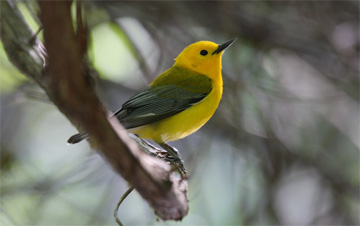
Traveling south, down the Mississippi Flyway, we move on to Region 4 and Tennessee’s Hatchie National Wildlife Refuge. It is located four miles south of Brownsville, on the south floodplain of the state-designated Scenic Hatchie River. The refuge, established in 1964, is now made up of 11,556 acres, mostly bottomland hardwoods and moist soil units. More than 97 percent of this refuge was acquired through MBCF/Stamp dollars. The meandering Hatchie is the last unchannelized river of its type in the Lower Mississippi River Valley. Within the refuge, elevations gently slope from 240 to 230 feet above sea level.
Major areas of conservation concern on the Hatchie include clearing of forests, with the resulting fragmentation of what woods remain, and changes to flooding patterns, which has caused inordinate sediment deposition in the refuge’s timberlands. To ensure wintering grounds for migrant waterfowl and warm weather nesting habitat for Wood Duck and Hooded Merganser, refuge managers employ water control, prescribed burns, cooperative farming, and other tools. Dabbling ducks on the refuge in early winter can be impressive.
Hatchie NWR is also recognized as a designated Important Bird Area, especially because of its significance for Mississippi Kites, Cerulean Warblers, and Swainson’s Warblers. Prothonotary Warblers, American Redstarts, and Acadian Flycatchers also nest commonly on the refuge.
At least 97 native fish species and 35 species of mussels have been identified in the Hatchie River, making it one of the richest fish faunas of all west Tennessee rivers, according to the refuge’s Comprehensive Conservation Plan (2006). The sloughs and wetlands provide ideal nursery conditions for juvenile aquatic denizens.
The archeological record of the valley shows human habitation as early as the late Archaic Period (ca. 3000 BCE). European explorers made contact with Chickasaw Nation in the sixteenth and seventeenth centuries. The Chickasaw ceded their lands to a growing young U.S. in 1818 and were removed to west of the Mississippi. In October 1862, Union forces under the command of Maj. Gen. Edward Ord won a minor victory over rebel soldiers led by Maj. Gen. Earl Van Dorn in the Battle of Hatchie’s Bridge.
Jim Baker has compiled an extensive photoset of images of the refuge. The second annual Hatchie BirdFest is scheduled for next May. The focus of Hatchie’s friends organization’s efforts has been an all-important river cleanup; the refuge and the river are also supported by the Tennessee Scenic Rivers Association.
This National Wildlife Refuge profile first appeared in the 19 December 2013 issue of Wingtips.